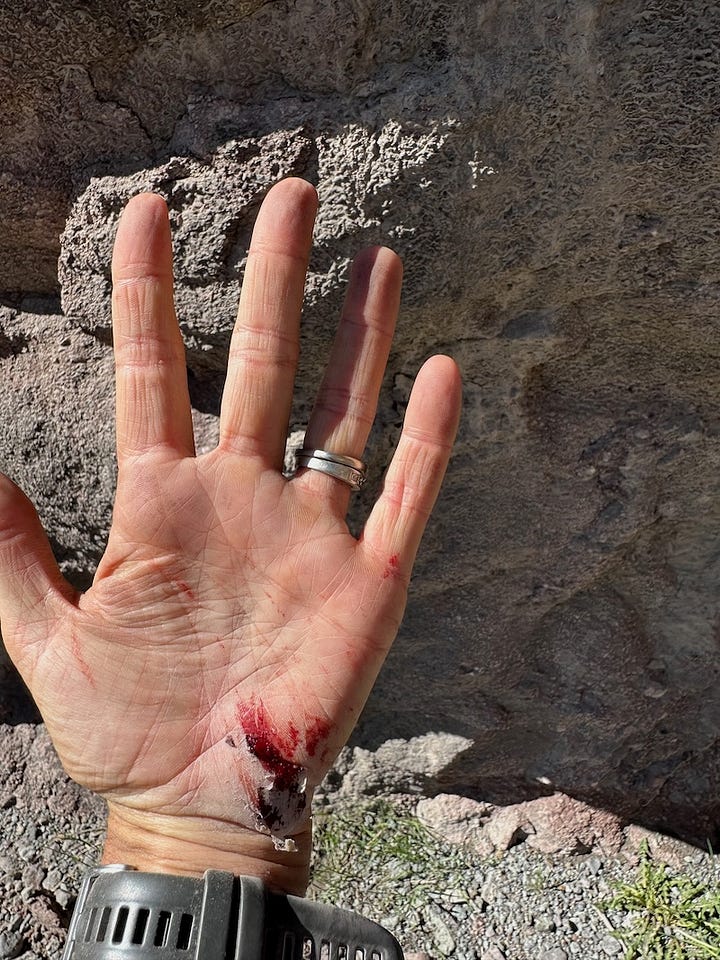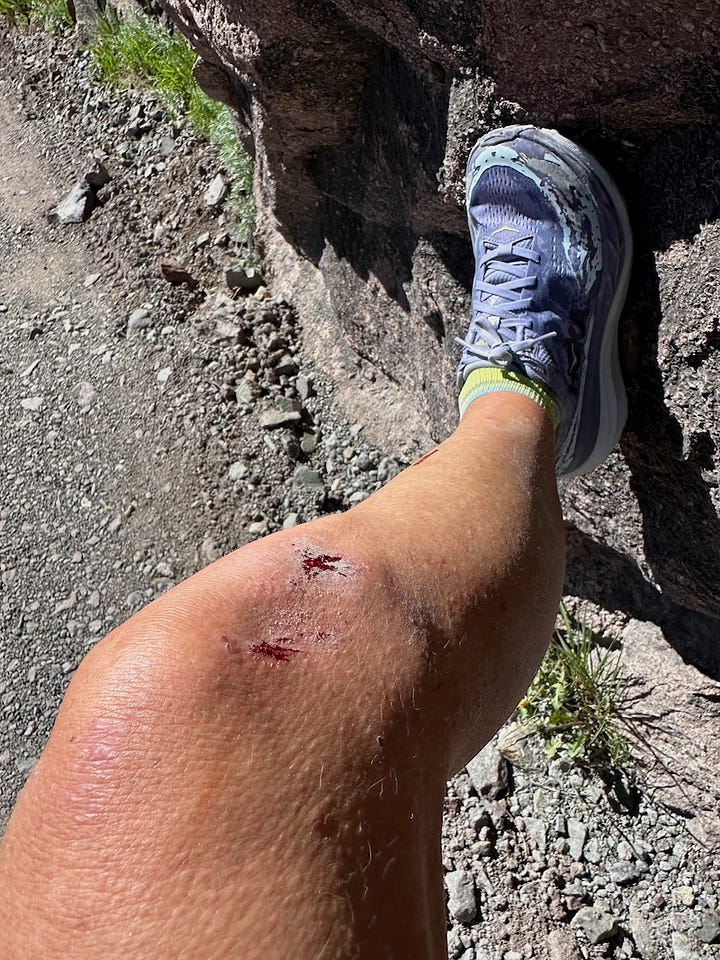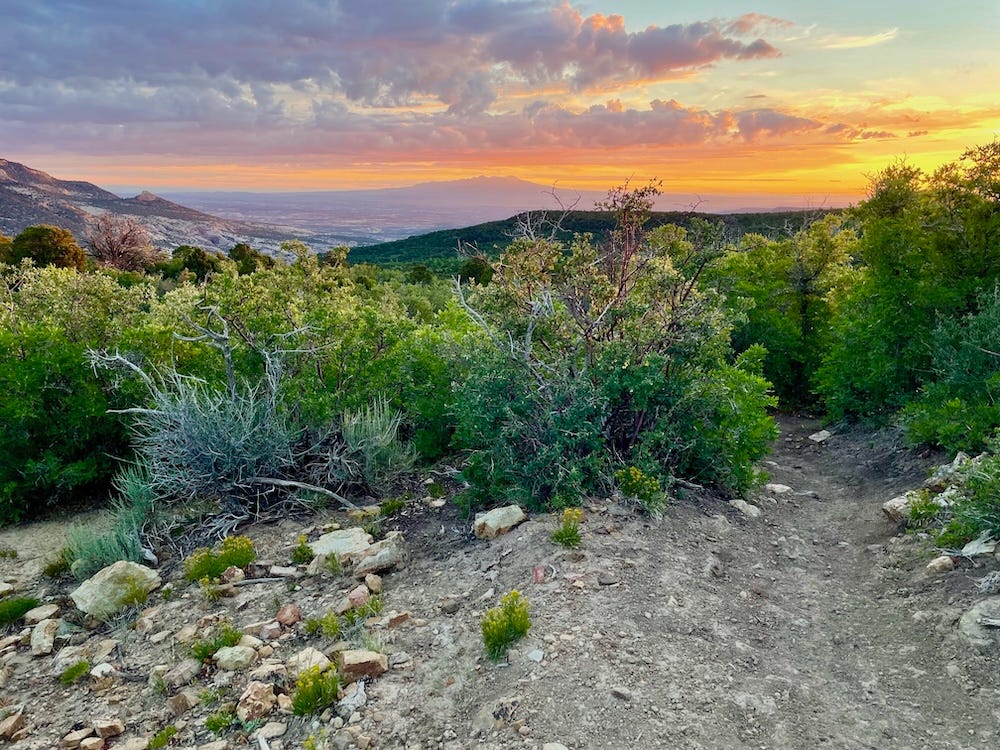Welcome back, or welcome new readers. Tomorrow, June 20, I host the monthly Zoom for paid subscribers, and we’ll have a special guest for a Q&A—a 59-year-old ultrarunner who last week finished extremely well, sixth female, in an extra-tough 100-miler. If you’d like to join the monthly online chat and receive occasional bonus posts, along with my deep gratitude, please consider upgrading your subscription to the supporter level.
I recently passed the fifth anniversary of moving year-round to my hometown of Telluride, which means more than five years have passed since I ran track regularly.
Amazingly, no running track exists in my town or any of the surrounding towns of Ridgway, Norwood, Ouray, or Silverton. I’d have to drive about 90 minutes to Montrose and sneak onto their high school track, which normally is closed to the public, or two hours to Durango if I wanted to run laps on a 400-meter track.
At first, I didn’t care. Miles of trails, dirt roads, and a relatively flat paved path beckon me and others to run around town. The local middle and high school kids seem to get in good-enough shape for cross country and track by running the bike path and doing drills on a field.
Then, I heard about a plan to build a track 45 minutes away at the middle/high school in Ridgway. The more I learned about it, the more excited I became.
I want to share a bit about what I’m doing to fast track plans to build a track for runners in the region, a topic that makes me reflect on the oval itself, the track.
What’s so special about a track?

I didn’t fall in love with running until I gave it a try away from the confines and precision of a track and discovered the relaxed, steady sensation and satisfaction of running by feel, not by time or distance. My first meandering, exploratory runs as a graduate student in my mid-20s took place on neighborhood sidewalks around Berkeley.
I was not a sporty girl, and the track intimidated me. In junior high, when we had to run a two-lap warmup on a track for PE, I became red-cheeked and winded while running behind most of the other girls, and the teacher threatened extra laps as punishment. In high school, I rode horses instead of playing team sports and ventured onto the track only occasionally to jog a mile while dieting. In college, when I chronically smoked, partied, and pulled all-nighters, running never crossed my mind. Exercise for me consisted of a quarter-mile walk from the student newspaper office to a nearby 7-Eleven to buy a frozen burrito nearly daily, and otherwise I rode a Honda scooter to get anywhere.
It took a supportive run group, then a coach, to make me venture onto a track in the East Bay Area in the mid-1990s. For the first time, I learned about 400s, 800s, 1200s, 1600s. And for the first time, I experienced motivation tinged with nerves as I hit the button on my stopwatch at the beginning of an interval. I would push my pace to catch up to the heels of another runner, accelerating as if slingshotted out of the curve onto the straightaway, sprinting the final 100 meters to shave a second or two off my time for that distance.
Running intervals on a track can go from feeling methodical to thrilling, exhausting, even gut-emptying. A track’s surface, flatness, precision, and regularity made me a better, faster, more passionate runner. I accomplished on track what I never could accomplish on road or trail. Midway through a mile time trial, giving everything a thirtysomething’s legs and lungs could muster to break six minutes, the painted white lane lines became mesmerizing, capturing the full effort and focus of tunnel vision. Seconds mattered, so running became suspenseful and dramatic.

To say that a runner doesn’t need a track is true. But, running off track is a bit like swimming in open water instead of in a pool with lanes, or riding dressage on a field without the regulation rectangular arena, or hitting a ball over a net without the lines of a tennis court. The athletes can’t measure their accuracy and progress without the precision of a standard setting.
A track also feels safe and manageable. I witnessed personal transformation and confidence-building at track workouts in the early 2000s as a mentor for Team in Training and for Students Run Oakland. Both of those programs trained beginner runners for marathons. To most of them, the track felt like a safe social haven rather than an intimidating or competitive place.
First they discovered a slow-and-steady pace while jogging the outside lanes. Gradually they progressed by accelerating with strides on the straights followed by jogging the curves. Then they challenged themselves with hard-effort one- and two-lap intervals. Finally, they attempted a full mile at a fast-for-them pace. Instead of just running “fast” or “slow,” they developed more nuanced “gears” or effort levels by running different paces at different distances on the track.
For these adults new to running, or these students from rough neighborhoods who didn’t feel safe running by themselves on sidewalks, the track became a destination for social support, a place where they could let go of life’s other pressures and worries and focus only on running that oval. Developing as a runner improved most other facets of their lives, as it did mine.
A track as a regional asset
Here in the San Juan Mountains, school populations are relatively low, and spring athletics, including track and field, seem to be treated as a bit of an afterthought to winter sports. Telluride’s high-quality high school has an athletic field but not a track, because the field alone barely fits between two town streets. North of Telluride, on the other side of the Sneffels range in Ridgway, the school district put in a soccer field but not a track. The grass field is so damaged due to poor drainage and other problems, it’s no longer used.
In spite of the lack of facilities, track and cross country are popular in the region, and local schools produce state champions who make do by practicing in alternate areas. Track teams shuttle one to two hours each way for occasional practices on tracks at schools farther away. Ridgway lacks anywhere for students to safely practice field events such as long jump, high jump, or hurdles, although the resourceful coach sets up a couple of hurdles in a school hallway for students to jump.
A couple of weeks ago, I attended a fundraiser and met the organizers of a $3 million campaign to replace Ridgway’s soccer field and put in an eight-lane all-weather track around it, along with a dedicated area for field events including high jump, long jump, discus, and pole vault. The new facility will be called the Cimarron Athletic Field, named after the mountains bordering Ridgway and Ouray.

It’s exciting to think how this track and field would inspire and improve a new generation of middle- and high-school athletes in our region. Ridgway could host regional track practices and meets that benefit all schools in our area.
But this project would do so much more than serve students at the schools. It would be a public community center for all ages, attracting runners and wanna-be joggers from around the region to improve themselves and support each other through running. The hope and plan is to break ground in spring of 2025, with completion by the end of that summer for the 2025-26 school year.
When this happens, I’m excited to support Telluride’s team to practice there, and personally, to make a pilgrimage to Ridgway two or three times a month during non-school hours to do a good ol’ track workout. To make it happen, I’ve gotten on board as a donor and also will host a fundraiser this August to build support among other local runners. A lot of the funding will come from the Ridgway school district and grants, but individual donors are very much needed to complete the track (the project’s second phase) after replacing the field (the first phase).
Want to help? Donations of any size are needed and appreciated. You can click this link to learn more and donate.
I found this short clip of finishing a lap during one of my last track workouts in early 2019, right before I turned 50 and moved permanently to Colorado. I miss the routine!
Do you have a track story to share? Has a local track empowered you or your kids to become a champ or develop fitness and wellness? Please share in the comments below.
When a race is not a race
This weekend, I’m driving east three hours to the Abajo Mountains near Monticello, Utah, for a 50-mile race. The lovely aspen-filled Abajos sit between the high-desert landscapes of Canyonlands National Park and Bears Ears National Monument.
I’m treating this race as a supported long training run, not a race that I care about competitively. Much like last April’s 100K, I view it as a stepping stone to training for my “A” goal later this season.
Some coaches advise their athletes not to toe the line of a race unless they’re willing and desiring to do their best. A race is a contest, an opportunity to test yourself against others. But I don’t subscribe to that all-or-nothing view, especially for ultrarunning. You can enter a race as a practice or dress rehearsal with goals that have nothing to do with beating others or improving your time.
Just as a track enables me run faster than I would off track, an ultra helps me run farther than I would self-supported and solo. My regular long runs top out at about six hours. Saturday’s event, which features some very slow and rugged sections plus heat, will take me about 13 hours. I’ll encounter challenges and need to prevent or troubleshoot problems—involving mindset, fueling, hydration, thermoregulation, and deep fatigue—that I rarely can simulate during my own long training runs.
Without a competitive goal, such as a time goal or a desire to finish in the top 10 or top in my age group, it’s important to set other goals to quash the inevitable thoughts that crop up around the 30-mile mark, e.g., “This feels like plenty for a quality training run, and my feet are killing me, so I think I’ll call it a day here.” My goals heading into Saturday include:
practice fueling and prevent nausea; be a smart eater and drinker to avoid the empty-tank bonk
avoid tripping and falling; be mindful and practice agility on the technical sections
lean into and accept the feelings of discomfort and slow-down as part of the process, especially if it’s high heat, rather than feeling discouraged or stressed by them
be nice and friendly toward others, even when I’m grumpy and annoyed
look around and notice details about the landscape; take photos with my mind instead of my phone
as best as possible, run (instead of walk) all of the final runnable miles on the gravel road
If I can meet those goals, I’ll feel accomplished even if I’m at the back of the pack. I’ll let you know next week how it goes.








I have some fond (ridiculous) memories running around the track in Silverton. Is it no longer there? It was a bit beat up but a track no less!
Just when I decided to take a hiatus from track workouts for a while to give my hamstring tendinitis a chance to heal. 😩 Seriously, great post. I’ve really enjoyed getting back to the track this past year, though largely for the social aspect.
Good luck on your non-race race next weekend! And ugh to the falling! I’ve been having stumbles lately from not picking up my foot enough on my injured side. No full blown falls recently, but sometimes I’ve hurt myself worse from the contortions of avoiding it. I’ve also noticed I tend to fall more in heavy mileage cycles, when I’m fatigued. You’re at peak training right now, so it’s not surprising.